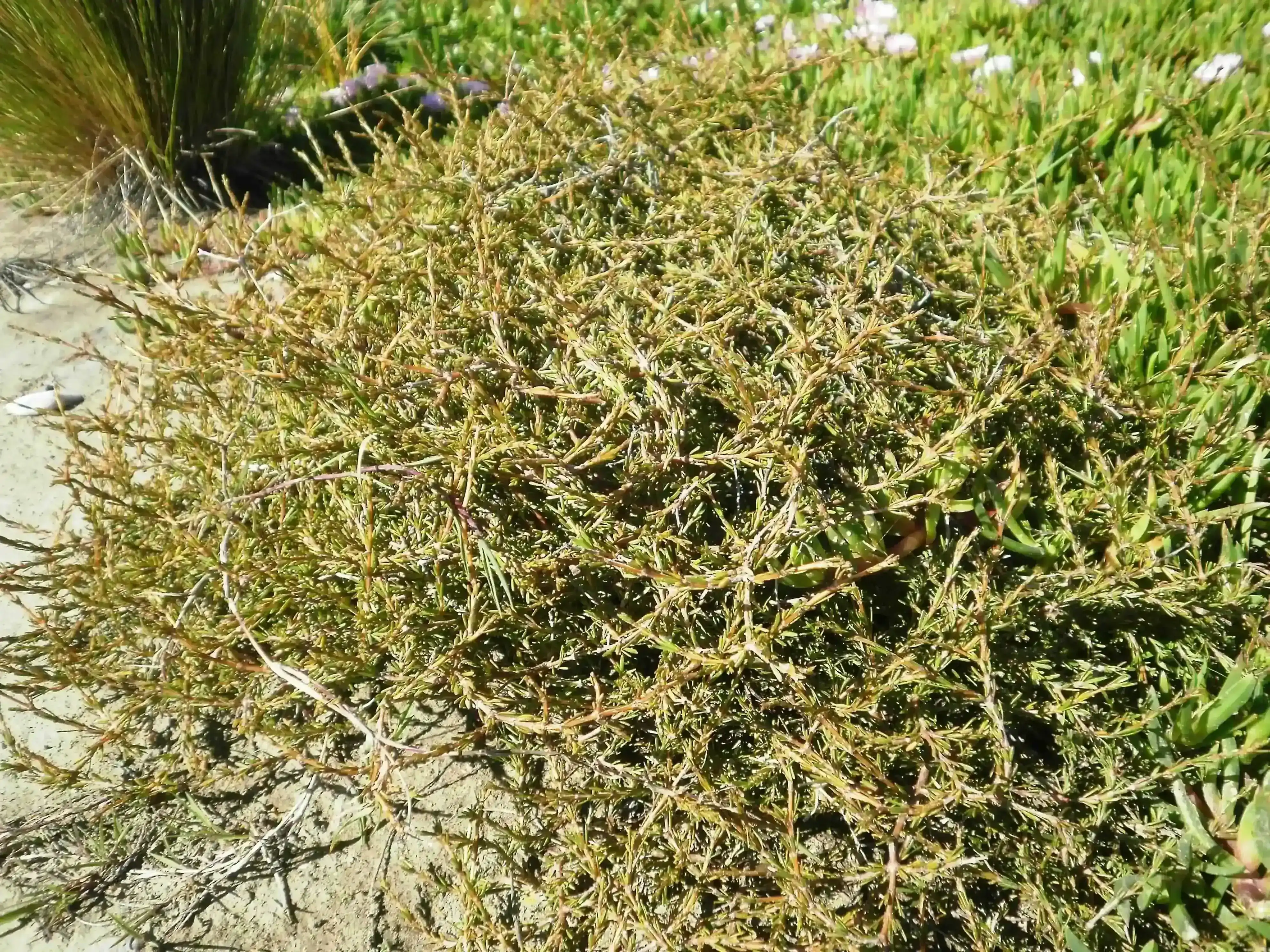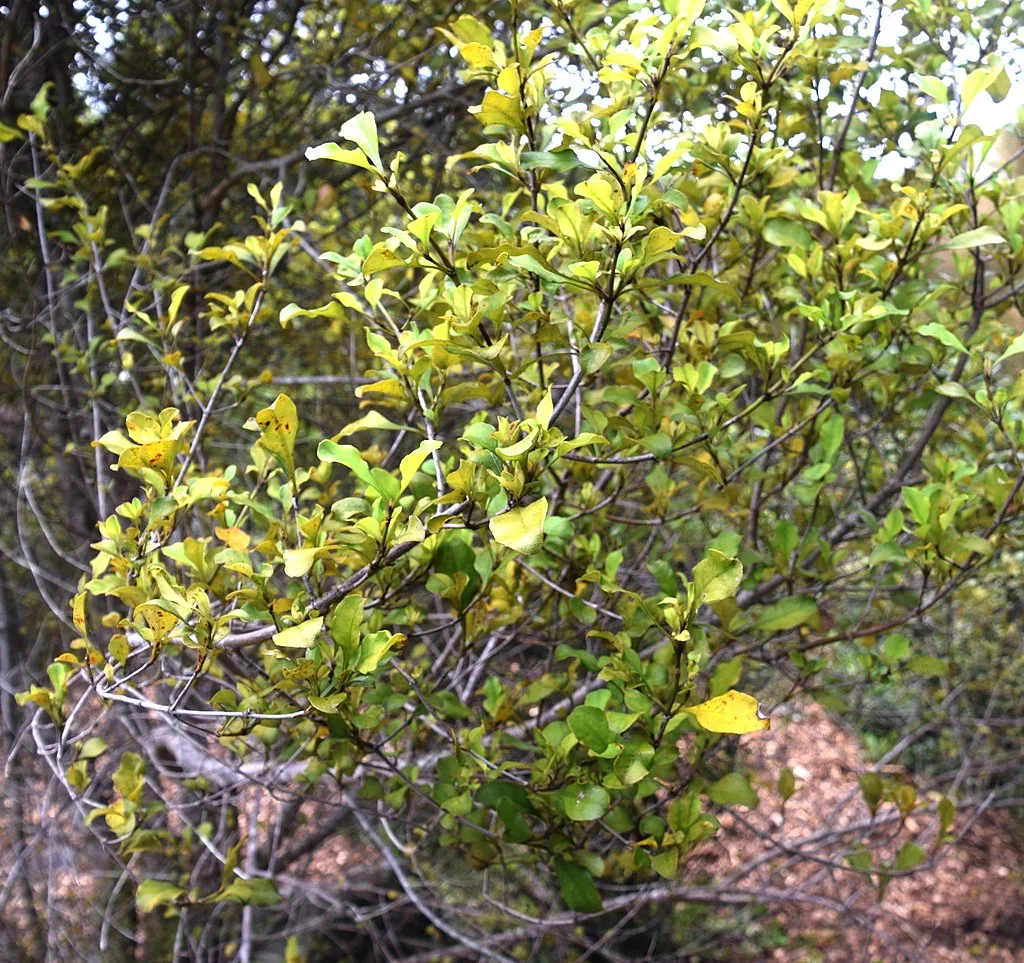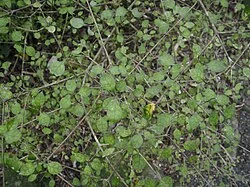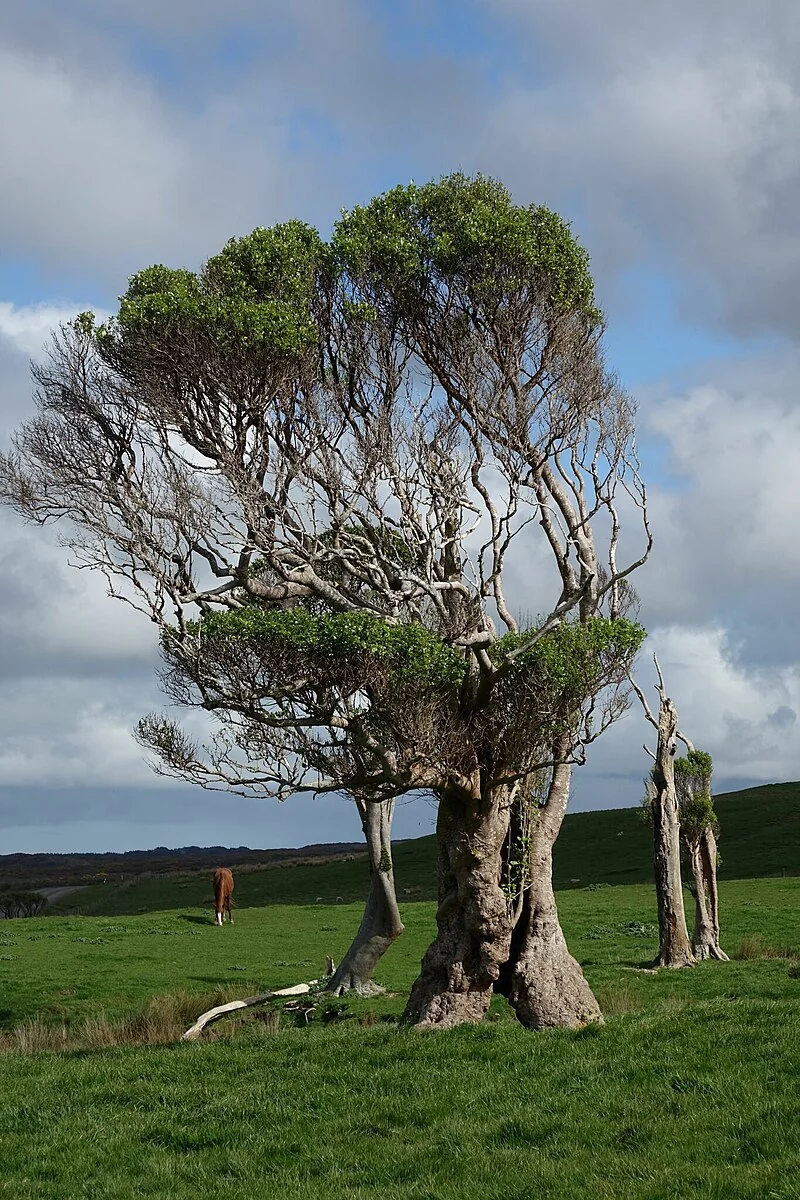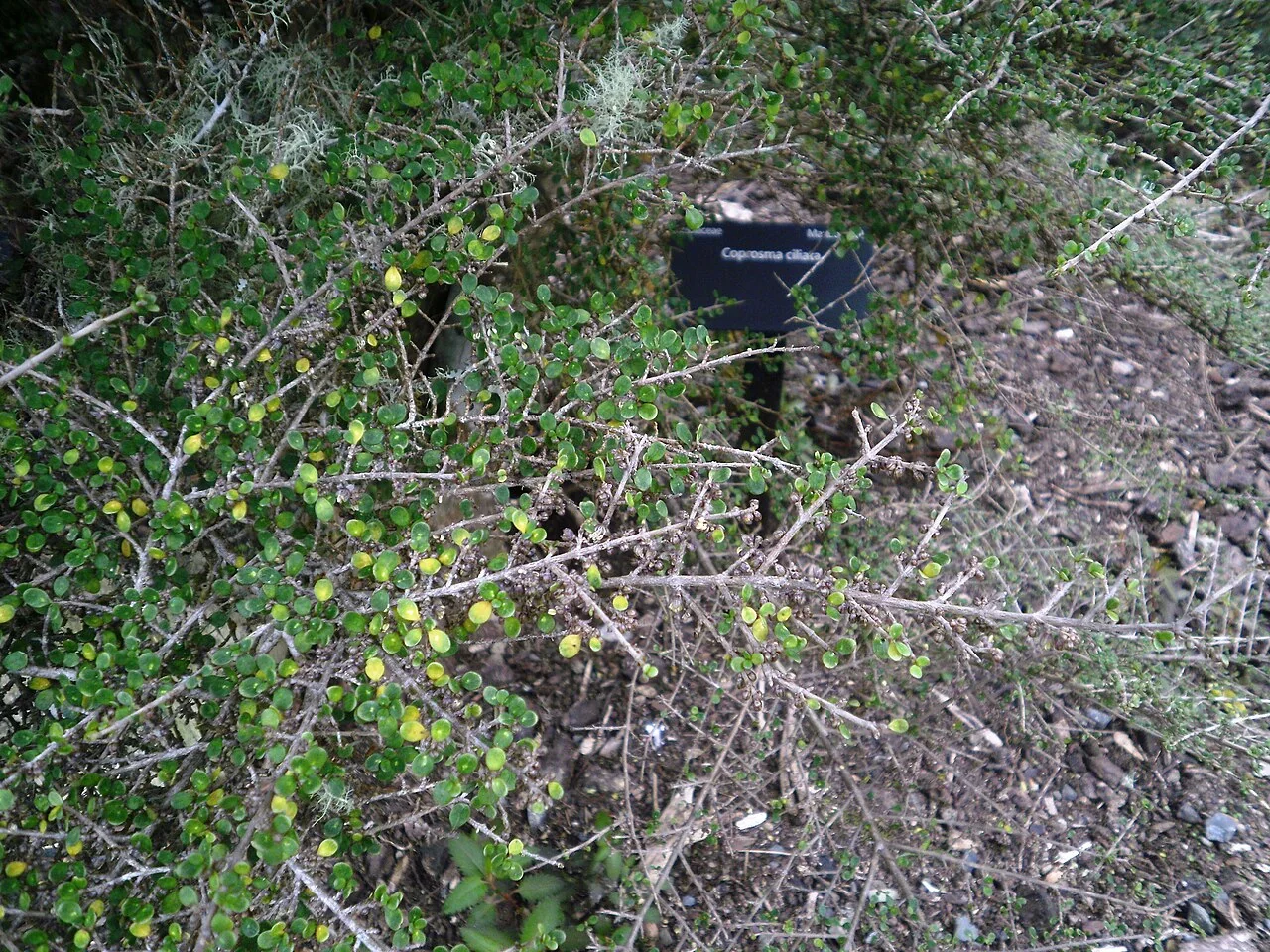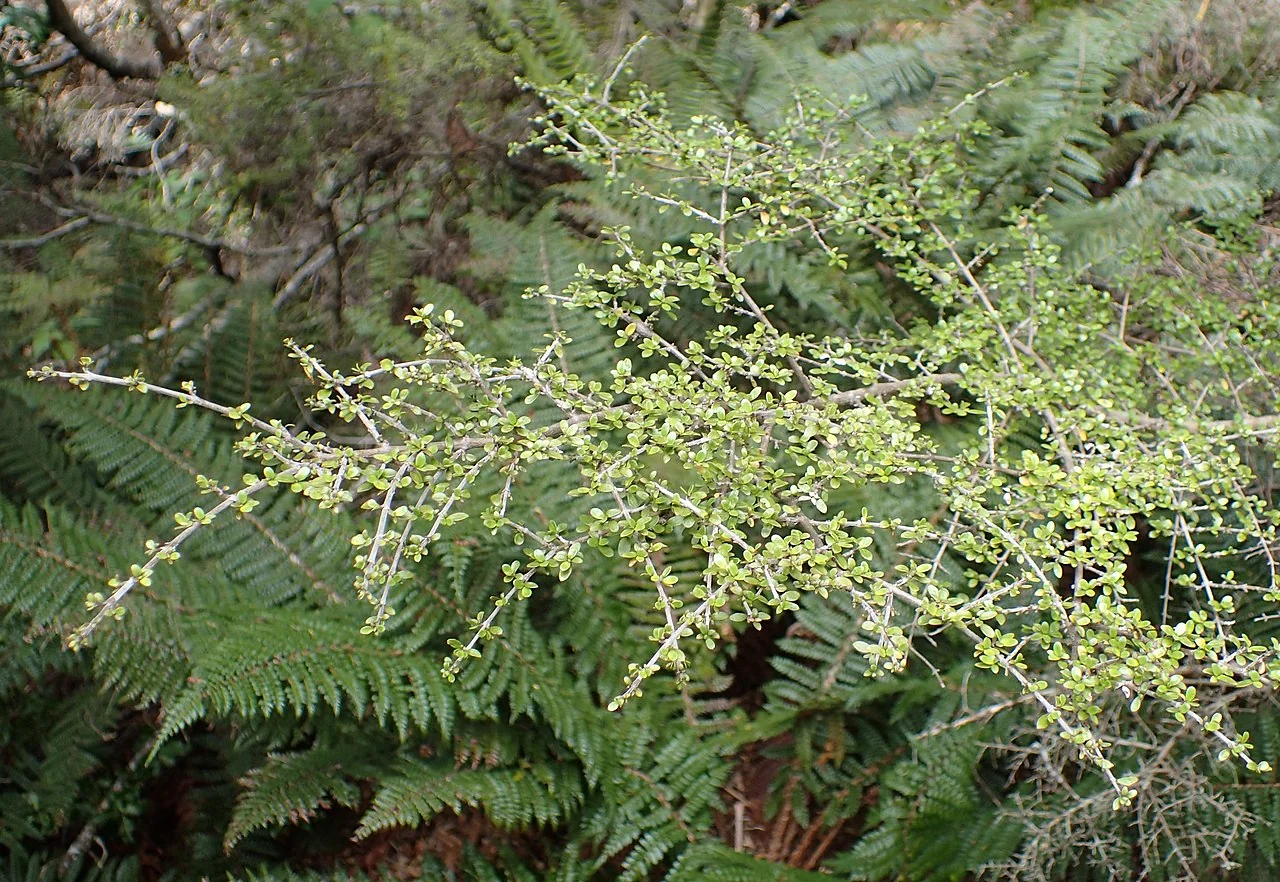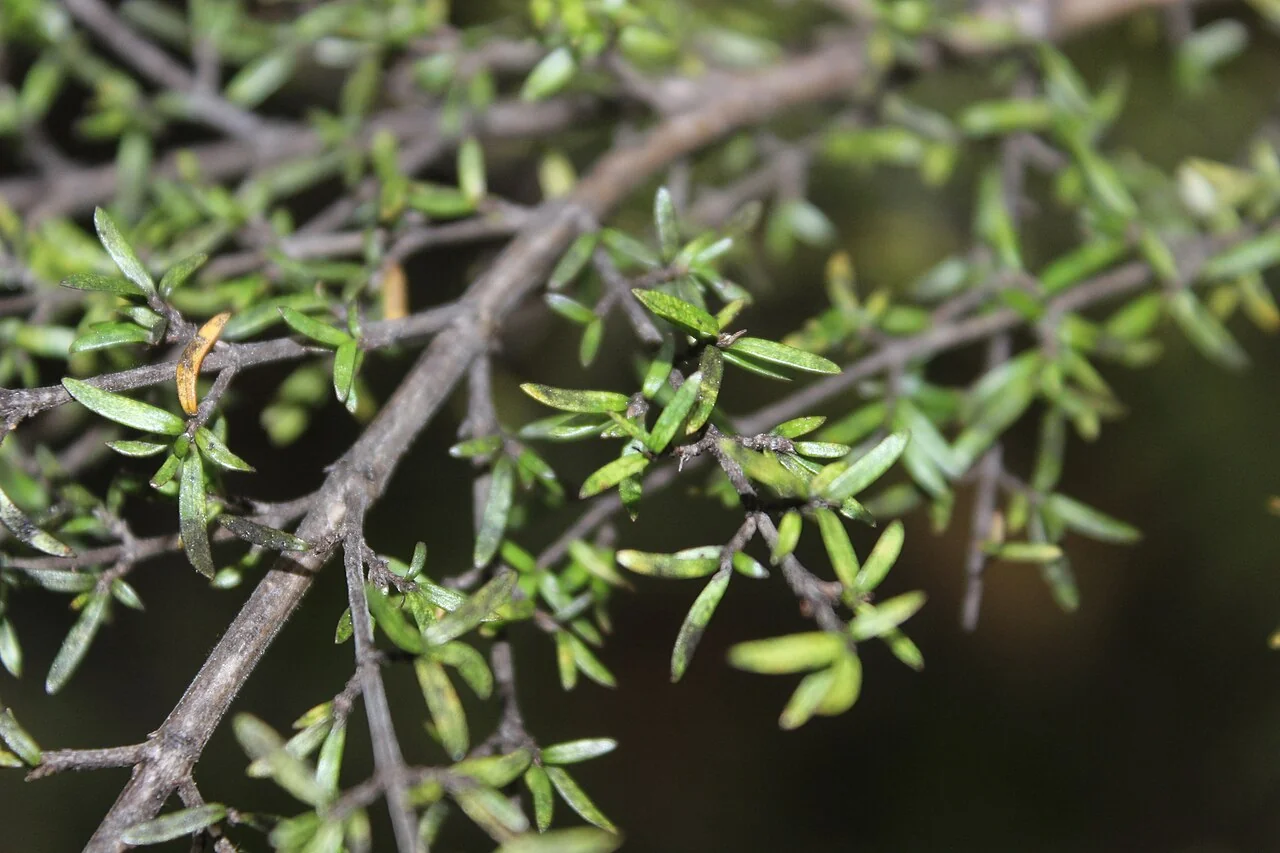
Small-Leaved Coprosma
Coprosma microcarpa
Coprosma microcarpa , also known as small-leaved coprosma or small-seeded coprosma, is a resilient evergreen shrub among New Zealand's native shrubs endemic to New Zealand. It typically grows as a densely branched, compact shrub, reaching 1-3 meters in height, though it can be smaller and more prostrate in harsh alpine conditions, and up to 4 meters in its natural habitat. Its most distinctive feature is its extraordinarily small, narrow, dark green, and leathery leaves, measuring just 5-15mm long and 1-3mm wide. These are arranged in opposite pairs along dark twigs, giving it a fine-textured, almost needle-like appearance. It produces tiny, numerous berries (drupes) that are typically white, though some sources mention bright red-orange berries. This species is highly adapted to harsh montane and subalpine environments, coastal cliffs, and exposed sites throughout New Zealand, thriving in conditions with extreme temperature fluctuations and high winds. It can be found from sea level up to 2000 meters elevation.

Plant Description
Botanical Features
Coprosma microcarpa , also known as Small-leaved Coprosma or Small-seeded Coprosma, is a resilient evergreen shrub endemic to New Zealand. It typically grows as a densely branched, compact shrub, reaching 1-3 meters in height, though it can be smaller and more prostrate in harsh alpine conditions, and up to 4 meters in its natural habitat. Its most distinctive feature is its extraordinarily small, narrow, dark green, and leathery leaves, measuring just 5-15mm long and 1-3mm wide. These tiny, narrow leaves are arranged in opposite pairs along dark twigs, giving the plant a fine-textured, almost needle-like appearance. It produces tiny, white, or bright red berries (drupes) that are typically 3-5mm in diameter. This species is highly adapted to harsh montane and subalpine environments, coastal cliffs, and exposed sites throughout New Zealand, thriving in conditions with extreme temperature fluctuations and high winds, from sea level up to 2000 meters elevation.
Quick Facts
| Scientific Name | Coprosma Microcarpa |
|---|---|
| Height | 0.2-0.8 m |
| Spread | 0.5-1.5 m |
| Water Needs | Low |
| Light | Full sun |
| Frost Tolerance | Excellent |
| Salt Tolerance | Poor |
| Growth Rate | Slow |
| Lifespan | Very long |
Climate Best Suited to
Small-fruited Coprosma ( Coprosma microcarpa ) thrives in cool, moist conditions with good drainage and shelter from harsh winds. It adapts well to typical New Zealand growing conditions with appropriate care and positioning.
Regional Suitability
| Whangārei | Ideal |
| Auckland | Ideal |
| Hamilton | Suitable |
| Rotorua | Suitable |
| Tauranga | Ideal |
| Gisborne | Ideal |
| New Plymouth | Ideal |
| Whanganui | Ideal |
| Palmerston North | Suitable |
| Napier | Ideal |
| Wellington | Ideal |
| Nelson | Ideal |
| Christchurch | Suitable |
| Dunedin | Suitable |
| Invercargill | Suitable |
| City | Climate Suitability |
|---|
Natural Habitat
Small-leaved Coprosma ( Coprosma microcarpa ) is a remarkably hardy species, endemic to New Zealand and perfectly adapted to some of the country's most challenging environments. It is found from sea level to altitudes of up to 2000 meters, inhabiting a wide range of habitats from coastal cliffs and exposed mountain sites to the understorey of lowland and montane forests. This versatility means it can be found on both the North and South Islands. It thrives in conditions that many other plants cannot tolerate, including high winds, severe frosts (down to -18°C), and poor, rocky, or sandy soils. The key to its survival in these diverse habitats is excellent drainage, as it cannot withstand waterlogged conditions. Its ability to colonize disturbed alpine sites makes it an important pioneer species, helping to stabilize scree slopes and contributing to the recovery of these fragile ecosystems.
Plant Conservation
Conservation Status and Alpine Habitat Protection
Coprosma microcarpa (Small-leaved Coprosma) is currently classified as "Not Threatened" under the New Zealand Threat Classification System, reflecting its relatively stable populations in alpine and subalpine environments across New Zealand. This endemic shrub occupies specialized high-altitude habitats where its distinctive small-leaved form and compact growth represent important adaptations to harsh mountain conditions.
However, like many alpine species, Small-leaved Coprosma faces emerging pressures from climate change, which threatens to shift suitable habitat zones to higher elevations and smaller available areas. Alpine ecosystems are particularly vulnerable to warming temperatures, changing precipitation patterns, and increased frequency of extreme weather events that can stress populations of specialized mountain plants. Additionally, invasive plant species, recreational pressures in alpine areas, and habitat fragmentation from infrastructure development pose ongoing challenges to maintaining healthy populations.
Conservation efforts focus on protecting alpine and subalpine habitats through reserve management, monitoring population trends, and maintaining genetic diversity within the species' range. Research into the species' ecological requirements and climate tolerances helps inform management strategies, while restoration projects in degraded alpine areas often incorporate Small-leaved Coprosma to restore natural ecosystem processes. The species plays important roles in alpine food webs through its berries, which support native birds, and contributes to soil stabilization in challenging mountain environments where its specialized root system helps prevent erosion.
Growing Requirements
Soil Requirements
Small-fruited Coprosma ( Coprosma microcarpa ) performs best in well-draining soil that retains adequate moisture. Like most New Zealand natives, it prefers soils that don't become waterlogged but maintain consistent moisture levels. Good drainage is essential for healthy root development.
- Well-draining soil essential for healthy growth
- Prefers consistent moisture without waterlogging
- Adapts to various soil types with good drainage
- Benefits from organic matter incorporation
- Mulching helps retain moisture and suppress weeds
Light Requirements
Small-fruited Coprosma ( Coprosma microcarpa ) performs well in full sun to partial shade conditions. Like many New Zealand natives, it adapts to various light conditions but typically shows best growth and form in positions that receive adequate sunlight throughout the day.
- Full sun to partial shade positions
- At least 4-6 hours of direct sunlight daily
- Tolerates light shade in warmer climates
- Morning sun particularly beneficial
Water Requirements
Small-fruited Coprosma ( Coprosma microcarpa ) requires regular watering during establishment, typically for the first 1-2 years. Once established, it becomes more drought-tolerant but benefits from consistent moisture during dry periods. Avoid overwatering which can lead to root problems.
- Regular watering during establishment phase
- Moderate drought tolerance once established
- Consistent moisture during dry periods beneficial
- Avoid waterlogged conditions
- Mulching helps conserve soil moisture
Planting Guide
When to Plant
The best time to plant Small-leaved Coprosma ( Coprosma microcarpa ) is in mid to late spring, allowing the plant to establish before the peak of summer heat. This timing helps ensure optimal root development and reduces transplant shock.
How to Plant
- Site Selection: Choose a location with full sun to partial shade. While it can tolerate partial shade, full sun promotes optimal growth and fruiting. Ensure the site has excellent drainage, as this plant cannot tolerate waterlogging.
- Soil Preparation: Dig a planting hole that is twice as wide and the same depth as the plant's root ball. Small-leaved Coprosma thrives in poor, rocky, sandy, or well-drained, low-fertility soils. A neutral to slightly acidic soil is ideal. If your soil is heavy or clay-based, add gypsum and organic matter like compost.
- Planting Procedure: Gently remove the plant from its container, tease out any circled or tangled roots, and position it in the hole so that the top of the root ball is level with the surrounding ground. Backfill the hole with a well-drained soil mix, enriching it with organic plant food or compost if desired. Firm the soil down gently.
- Initial Watering: Form a raised ring of soil around the outer edge of the plant's root zone to help retain water. Water thoroughly immediately after planting to settle the soil around the roots.
Initial Care
- Watering: During the first growing season, ensure the plant receives regular, deep watering (once or twice a week) to help establish its root structure. Do not allow the soil to dry out completely during this period.
- Mulching: Apply a layer of organic mulch around the base of the plant to help retain soil moisture, regulate soil temperature, and suppress weeds. Note that for this alpine specialist, minimal or no mulch is required, and a watering basin is not needed due to its drought tolerance.
By following these guidelines, you can ensure a successful establishment and healthy growth for your Small-leaved Coprosma, allowing it to thrive in your garden.
Ecological Role
Small-leaved Coprosma ( Coprosma microcarpa ) is a structural and trophic lynchpin of exposed montane and subalpine communities. Its compact, wind-sculpted habit and tough, small foliage allow it to persist where few woody species can, creating shelter, binding fragile substrates, and supplying seasonal food resources that sustain alpine food webs.
Food and Dispersal Networks
- Bird-dispersed fruit: The small, fleshy drupes are readily eaten by native frugivores; seeds are dispersed downslope and across ridgelines, stitching together sparse shrublands and colonising open scree.
- Nectar/pollen for insects: Though the flowers are inconspicuous, they provide pollen and shelter for alpine invertebrates during brief summer windows.
- Dioecious dynamics: Like many Coprosma , plants are male or female; local sex ratios influence fruit set and the magnitude of bird visitation.
Habitat Engineering
- Microclimate creation: Dense twigging and close foliage reduce wind speed at the surface, buffering temperature extremes and creating refuges for invertebrates, lichens, and seedling recruitment of less hardy species.
- Soil stabilisation: Fibrous root systems interlock coarse, fast-draining gravels, stabilising talus and roadcut faces and reducing rill erosion in storm events.
- Snow and frost resilience: Low, pliant branches shed snow loads and resist frost desiccation, maintaining year-round cover and continuity of habitat structure.
Successional Role
- Pioneer on harsh sites: Quickly occupies raw substrates after disturbance (rockfall, slips, track work), preparing the ground-physically and biologically-for later-arriving shrubs and tussocks.
- Nurse effect: Its canopy traps organic matter and moderates vapour pressure deficit, improving establishment conditions for co-occurring alpine herbs and grasses.
Interactions and Pressures
- Herbivory: Naturally unpalatable foliage offers moderate browse resistance, but seedlings can be suppressed by high ungulate or lagomorph pressure on alpine fronts.
- Weed competition: On lower, drier sites it competes with invasive shrubs and grasses; maintaining open, stony conditions favours Coprosma microcarpa .
- Climate sensitivity: Increasing frequency of warm, wet winters can encourage pathogen pressure on poorly drained soils; excellent drainage remains critical.
By binding substrate, moderating exposure, and fuelling dispersal networks, C. microcarpa enhances landscape resilience across New Zealand's windy ridges, bluffs, and alpine benches-small in stature but disproportionately important to ecosystem function.
Uses and Significance
Garden Uses
- Excellent for native plant gardens and restoration
- Suitable for naturalistic landscape designs
- Low maintenance once established
- Contributes to local biodiversity
- Attractive to beneficial native wildlife
Cultural Significance
Traditional Uses and Values
Small-leaved Coprosma ( Coprosma microcarpa ) holds cultural significance as part of the diverse Coprosma family, many species of which were traditionally used by Māori for various purposes, including medicinal applications (rongoā) and as food sources. Its resilience and adaptability to harsh alpine and coastal environments also contribute to traditional ecological knowledge, highlighting the interconnectedness of native flora and fauna.
Landscaping Uses
Coprosma microcarpa , also known as Small-leaved Coprosma or Small-seeded Coprosma, is a versatile and hardy evergreen shrub with several landscaping applications, particularly suited for challenging environments. Its small, needle-like or leathery leaves and compact form provide textural contrast and visual interest in various garden designs.
Key Landscaping Uses:
- Alpine and Rock Gardens: It is an authentic choice for creating mountain-themed landscapes, crevice plantings, and scree garden compositions due to its adaptation to harsh conditions and excellent drainage requirements.
- Groundcover: It can be used as a small-scale groundcover, especially in harsh conditions or mass planted on banks.
- Extreme Climate Landscaping: Ideal for sites too harsh for conventional shrubs, as it tolerates full sun, wind, and drought once established.
- Miniature Landscapes and Container Culture: Its compact form and fine texture make it suitable for small-scale gardens and specialized container displays.
- Borders and Mixed Plantings: It can be included in borders and mixed plantings to add texture and form.
- Hedging: While it naturally has a compact form, it can be lightly trimmed for formal appearances or used for hedging.
- Erosion Control: Its root systems help stabilize slopes and scree in steep mountain terrain, making it useful for erosion control.
- Wildlife Support: The minute red or white berries attract small birds and provide crucial food, while its dense branching creates microhabitats for alpine invertebrates and small animals.
- Pioneer and Riparian Plantings: It acts as an early colonizer of disturbed alpine sites, facilitating ecosystem recovery.
Coprosma microcarpa thrives in well-drained, poor, rocky, or sandy soils and prefers full sun for best growth and fruiting, though it tolerates partial shade. It requires minimal watering due to its exceptional drought tolerance.
Seasonal Care Calendar
Spring
Spring is an active growth period for Small-fruited Coprosma ( Coprosma microcarpa ). New growth emerges and this is an ideal time for planting new specimens. Monitor soil moisture as temperatures warm and growth accelerates.
- Active growth period with new foliage development
- Ideal time for planting new specimens
- Monitor soil moisture as temperatures rise
- Apply organic mulch if needed
Summer
Summer is typically the main growing season for Small-fruited Coprosma ( Coprosma microcarpa ). Ensure adequate watering during hot, dry periods, especially for young plants. Established plants show good heat tolerance with appropriate care.
- Peak growing season with active development
- Monitor watering needs during hot weather
- Young plants need consistent moisture
- Established plants show good heat tolerance
Autumn
During autumn, Small-fruited Coprosma ( Coprosma microcarpa ) begins to slow its growth as temperatures cool. This is another good time for planting as conditions become more favorable. Reduce watering frequency but maintain soil moisture.
- Growth slows as temperatures moderate
- Good time for planting new specimens
- Reduce watering frequency gradually
- Maintain soil moisture without overwatering
Winter
Winter is typically a dormant period for Small-fruited Coprosma ( Coprosma microcarpa ). With minimal growth activity. Reduce watering but ensure plants don't completely dry out. Most New Zealand natives are cold-hardy and require minimal winter protection.
- Dormant period with minimal growth activity
- Reduce watering but avoid complete drying
- Generally cold-hardy in most New Zealand climates
- Minimal winter protection required
When to Prune and How Much
Small-fruited Coprosma ( Coprosma microcarpa ) generally requires minimal pruning to maintain its natural form and health. Most maintenance involves removing dead or damaged growth and light shaping if needed.
- Remove dead, damaged, or diseased growth as needed
- Light pruning to maintain shape if desired
- Prune after flowering if applicable
- Avoid heavy pruning which can stress the plant
- Use clean, sharp tools to prevent disease
- Most natives maintain good form without regular pruning
Always use clean, sharp tools when pruning to minimize disease risk. Native plants typically maintain their natural form well and often require less intervention than exotic species.
How to Grow Small-Leaved Coprosma
From Fresh Tiny White Berries
Fresh tiny white berry propagation represents the most authentic method for growing Small-leaved Coprosma, taking advantage of this alpine specialist's unique fruit production and natural dispersal strategy that has enabled it to establish in harsh montane and subalpine environments from sea level to 2000 meters elevation throughout New Zealand. This extraordinary endemic produces minute white drupes that provide opportunities for propagation while reflecting the species' adaptation to extreme conditions including severe temperature fluctuations, high winds, and challenging alpine soils. The species' remarkable tolerance to harsh montane environments makes it particularly valuable for specialized alpine restoration projects and challenging garden sites requiring plants capable of withstanding extreme conditions that defeat most other species. Fresh berries yield significantly higher germination success compared to stored seeds, making immediate processing and sowing essential for this alpine specialist that demands careful attention to replicating natural germination conditions. Collect ripe berries when fruits have achieved their characteristic small white coloration and can be carefully removed from dark branches arranged in flat planes, timing collection to coincide with peak ripeness when seeds have reached maximum viability for successful establishment in specialized growing conditions. Choose berries that are fully developed despite their minute size, showing the distinctive white coloration typical of mature fruit while avoiding any that appear damaged, diseased, or prematurely dropped which might indicate compromised seed quality in this already challenging species. Process berries immediately after collection by careful removal of all pulp, as residues can significantly hinder germination in this sensitive alpine species, using gentle techniques under running water to separate the tiny seeds from fruit material. Clean seeds meticulously by repeated gentle washing until all fruit debris is completely removed, as even trace amounts of pulp can inhibit germination in this species that requires pristine conditions for successful establishment. Prepare specialized germination medium using very free-draining seed-raising mix with exceptional aeration properties designed for alpine species, ensuring pH levels between 6.0-7.0 while incorporating coarse materials that replicate the sharp drainage essential for this montane specialist. Sow fresh seeds immediately after processing, covering lightly with 2-3mm of fine sand to provide optimal conditions while maintaining the excellent drainage essential for preventing the fungal problems that can quickly destroy alpine species during germination. Provide optimal environmental conditions including consistent temperatures between 15-22°C, bright light, and careful moisture management that maintains even moisture without waterlogging throughout the extended germination period characteristic of alpine plants. Maintain meticulous moisture control throughout the 4-10 week germination period, as this species exhibits slow and irregular germination patterns requiring exceptional patience and consistent environmental conditions while monitoring for the subtle emergence signs typical of alpine specialists. Keep propagation trays for extended periods to accommodate the highly variable germination timing characteristic of this mountain species, ensuring optimal conditions are maintained throughout potentially lengthy emergence windows that may extend well beyond typical expectations. Young seedlings develop extremely slowly while establishing the specialized root systems necessary for adaptation to harsh alpine growing conditions, requiring prompt but careful transplanting into tubes containing gritty, sandy mix specifically formulated for alpine species. Grow seedlings in high light conditions with modest feeding regimens that support healthy development without promoting excessive soft growth vulnerable to the environmental stresses these plants must withstand in their natural alpine habitats. Harden off gradually and plant only in sharply drained, cool sites that closely mirror the species' natural alpine and subalpine habitats while carefully avoiding humid, stagnant conditions that can quickly kill this mountain specialist adapted to extreme environmental conditions.
From Semi-Hardwood Cuttings
Semi-hardwood cutting propagation offers a specialized vegetative method for growing Small-leaved Coprosma that preserves the exact genetic characteristics of exceptional parent plants while providing results for experienced propagators working with alpine plant cultivation and specialized mountain restoration projects. This approach is particularly valuable for maintaining superior specimens that demonstrate exceptional cold tolerance, enhanced alpine adaptation, or other critical traits that can be preserved through careful vegetative propagation techniques specifically suited to this challenging alpine specialist. The method requires advanced horticultural skills and meticulous attention to environmental conditions, as this mountain species presents unique challenges that demand specialized techniques developed through alpine plant propagation experience. Take 5-8cm semi-hardwood cuttings from healthy current-season shoots during late spring to early autumn when growth has achieved optimal maturity for rooting while retaining sufficient vigor for successful establishment under precisely controlled alpine propagation environments. Select healthy, vigorous shoots from the middle portions of branches that display the characteristic tiny dark green leaves arranged on dark branches in flat planes typical of healthy Small-leaved Coprosma development adapted to mountain conditions. Cut sections with sterilized, sharp tools, ensuring each cutting includes appropriate nodal development while selecting material that represents the best characteristics of the parent plant including compact alpine growth habit and the distinctive tiny foliage that characterizes this species. Remove lower leaves carefully to reduce transpiration stress while retaining sufficient photosynthetic capacity in remaining tiny leaves, taking exceptional care not to damage the minute foliage that provides essential energy for root development during the challenging establishment period. Lightly wound the base if stems are smooth to enhance root initiation, using gentle techniques that expose cambium tissue without causing excessive damage to cutting material from this sensitive alpine species. Apply rooting hormone of low to moderate strength immediately after preparation, using formulations specifically appropriate for challenging alpine species to enhance root initiation while ensuring even coverage of cut surfaces where new root systems must develop under demanding conditions. Insert prepared cuttings into coarse, fast-draining medium such as 1:1 perlite and coarse sand, ensuring exceptional drainage while maintaining the precise moisture levels essential for successful root development without creating waterlogged conditions that can quickly kill alpine species. Maintain optimal environmental conditions including bright light, high humidity without prolonged leaf wetness, and gentle bottom heat around 18-22°C if available, providing conditions that support root development while preventing the stress that can easily destroy challenging alpine species. Provide bright light that supports photosynthesis without causing excessive transpiration stress, replicating the intense but filtered light conditions where this species naturally thrives in exposed alpine and subalpine environments. Keep growing medium just moist throughout the 4-8 week rooting period, maintaining consistent environmental conditions while watching for subtle signs of successful root development that may be less obvious in this slow-growing alpine specialist. Root development occurs very gradually as cuttings establish the specialized fibrous root systems characteristic of mature Small-leaved Coprosma plants adapted to harsh alpine soils, requiring exceptional patience and consistent care throughout the extended establishment process. Pot successful cuttings into gritty, well-drained mix specifically formulated for alpine species and harden off gradually before planting into permanent locations that provide the sharp drainage and challenging conditions necessary for this mountain specialist to thrive in cultivation.
From Alpine Habitat Layering
Alpine habitat layering provides a natural propagation method for Small-leaved Coprosma that takes advantage of this species' growth habit and natural reproduction strategies adapted to harsh mountain environments where traditional propagation methods often fail. This technique works particularly well with Small-leaved Coprosma because of its bushy growth form with twigs arranged in flat planes that naturally create opportunities for contact with suitable growing medium under alpine conditions. The method mimics natural reproduction strategies while providing reliable results for alpine gardeners seeking to propagate this challenging mountain specialist using techniques that replicate the harsh conditions where this species naturally establishes and survives. Understanding this natural process provides insights into the species' alpine ecology while offering practical propagation techniques that require minimal specialized equipment but demand understanding of alpine growing conditions. Select healthy, flexible shoots from vigorous parent plants during the growing season when active growth supports development under challenging alpine conditions, choosing shoots that can be positioned in contact with specially prepared alpine growing medium. Identify suitable layering locations that replicate the sharp drainage and challenging conditions typical of this species' natural alpine habitat, ensuring growing medium provides the exceptional drainage essential for root development without waterlogging. Prepare specialized layering sites using gritty alpine growing mix that incorporates coarse materials to create the sharp drainage and challenging conditions that support root development while preventing the waterlogged conditions that can quickly kill this mountain specialist. Create partial wounds in shoot sections that will be buried by making small cuts that expose cambium tissue where new roots will develop, using techniques that minimize damage while encouraging root initiation under challenging alpine conditions. Pin wounded shoot sections beneath shallow layers of gritty alpine mix, using securing methods that maintain consistent contact while allowing natural growth processes to proceed under the demanding conditions required by this mountain species. Cover layered sections appropriately with specialized alpine growing mix that provides root development support while maintaining the exceptional drainage necessary for successful establishment without creating conditions that can damage this sensitive alpine specialist. Mark layering sites clearly to prevent accidental disturbance and maintain careful moisture management throughout the rooting period, as reliable but minimal water availability is critical for root development in this species adapted to challenging alpine moisture regimes. Monitor layered sections regularly for signs of successful rooting, typically indicated by new growth emerging from buried areas after extended periods under the challenging conditions required for this slow-growing alpine specialist. This method proves useful where stock plants are limited or when maintaining connection to parent plants throughout establishment provides advantages for challenging alpine propagation situations that demand specialized approaches. Sever connections to parent plants only after successful root establishment is confirmed through careful testing, ensuring new plants have developed sufficient specialized root systems to support independent growth in challenging alpine conditions before transplanting to permanent mountain garden locations. This approach provides excellent results with techniques specifically adapted to alpine conditions while maintaining the genetic characteristics of superior parent plants, making it ideal for specialized alpine gardeners seeking to expand populations of this remarkable mountain species through natural propagation methods that replicate the harsh conditions essential for successful cultivation of this demanding alpine specialist.
Pests and Diseases
Coprosma microcarpa , a hardy New Zealand native, is generally resilient to pests and diseases, often suffering more from over-care than from natural threats. However, it can be affected by certain issues.
Common Pests:
- Scale Insects: Are rarely problematic for Coprosma microcarpa due to its harsh growing conditions. Severe infestations can cause yellowing, but they are usually self-regulating.
- Coprosma white erineum mite (Phyllocoptes coprosmae): Is an endemic gall mite that causes white, hairy growths (erineum) on the underside of leaves, sometimes leading to yellowing on the upper surface.
- Other general pests: That can affect Coprosma species, including potentially C. microcarpa, are leafhoppers, aphids, mealybugs, borers (weevils), and thrips. These can cause symptoms like stunted growth, discoloration, wilting, and leaf damage.
Common Diseases:
- Overwatering issues and root rot: Are the most common problems for Coprosma microcarpa , stemming from excessive water or poor drainage. Symptoms include yellowing foliage, soft growth, and root rot. Improving drainage and reducing watering are key management strategies.
- Fungal leaf spots: Are also observed. A common one is caused by Mycosphaerella coacervata (or its anamorph Phyllosticta coprosmae), which manifests as pale yellow, circular, or irregular spots on the underside of leaves, turning yellow on the upper surface and eventually brown. General fungal spots can also occur, thriving in moist conditions and causing discoloured patches on leaves and stems.
- Other diseases: Noted in Coprosma species include leaf drop (wilting, yellowing, and premature shedding) and yellow edges disease (yellowing and withering of leaf margins).
Bonus Tip
Expert Growing Advice
Small-leaved Coprosma ( Coprosma microcarpa ) is an incredibly hardy and adaptable plant, thriving in some of New Zealand's most challenging environments, from coastal cliffs to high alpine zones. Its dense, compact growth and tiny leaves are adaptations to extreme conditions, making it an excellent choice for rock gardens, exposed sites, or as a tough groundcover where other plants struggle. Ensure excellent drainage to prevent root rot.
